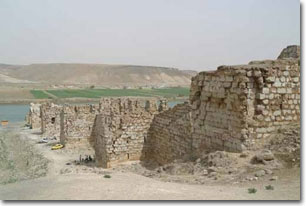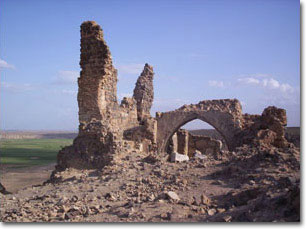|
 On the
left bank of Mid Euphrates (across Zalebiye) 66 km north of Deir Ezzor
(100 km south of Raqqa); Halebiye was one of the most formidable
Byzantine fortifications in Syria, the culmination of Justinian's
ambitious policy of securing the frontier of the Later Roman Empire on
the Euphrates. The site is particularly splendid at sunset when the
shadows fall across the stark hills and the sun strikes a warmer
luminescence in the stone. On the
left bank of Mid Euphrates (across Zalebiye) 66 km north of Deir Ezzor
(100 km south of Raqqa); Halebiye was one of the most formidable
Byzantine fortifications in Syria, the culmination of Justinian's
ambitious policy of securing the frontier of the Later Roman Empire on
the Euphrates. The site is particularly splendid at sunset when the
shadows fall across the stark hills and the sun strikes a warmer
luminescence in the stone.
Though what you now see is basically Byzantine construction of the
sixth century, Halebiye was first fortified during the apogee of
Palmyrian control in the area, in the mid third century. When the
Romans responded to Zenobia's rebellion by occupying the Palmyrene
domains in 273, they took Halebiye (named after a Palmyrian Queen). 
The great consolidation of the site dates to the reign of the Byzantine
Emperor Justinian (ruled 527 - 65). In Syria, he put considerable store
by retaining control of a region which had become an important center
of Christianity and securing it against the Persian threat. Halebiye
along with the earlier fortifications of the pilgrimage city of Resafe
were the most conspicuous results of his policy. The Arabs used the great fortification from time to time but it was
later largely left to decay. The fortifications originally contained a
small garrison city with the usual range of amenities within the 12 ha
walled area. Also the citadel speaks of how many occupiers re-fortified
it. And last but not least, the funerary towers and rock-cut tombs of
the late Roman period can be watched along the river to the north of
the city. Zalebiye:  On the right bank of Mid Euphrates (across Halebiye) 66 km north of
Deir Ezzor (100 km south of Raqqa); the history of Zalebiye marches
closely with that of the complementary fortress on the Euphrates,
Halebiye. Being in a worse state of preservation, smaller in extent,
and until recently less accessible, Zalebiye has been infrequently
visited. On the right bank of Mid Euphrates (across Halebiye) 66 km north of
Deir Ezzor (100 km south of Raqqa); the history of Zalebiye marches
closely with that of the complementary fortress on the Euphrates,
Halebiye. Being in a worse state of preservation, smaller in extent,
and until recently less accessible, Zalebiye has been infrequently
visited.
The fortress, like Halebiye, was established in the period when the
Palmyrene were unwisely attempting to assert their control in the area
to test Roman dominance. It was improved as part of the defensive works
of the Byzantine Emperor Justinian. It was more damaged than Halebiye
due to the use of less solid construction techniques and earthquakes
and river flooding effects. These works probably date back at least to the first century AD and
probably to the late Bronze Age. The canal was still in use in the Arab
middle ages when it was named after Semiramis, the legendary Arab
queen. |


